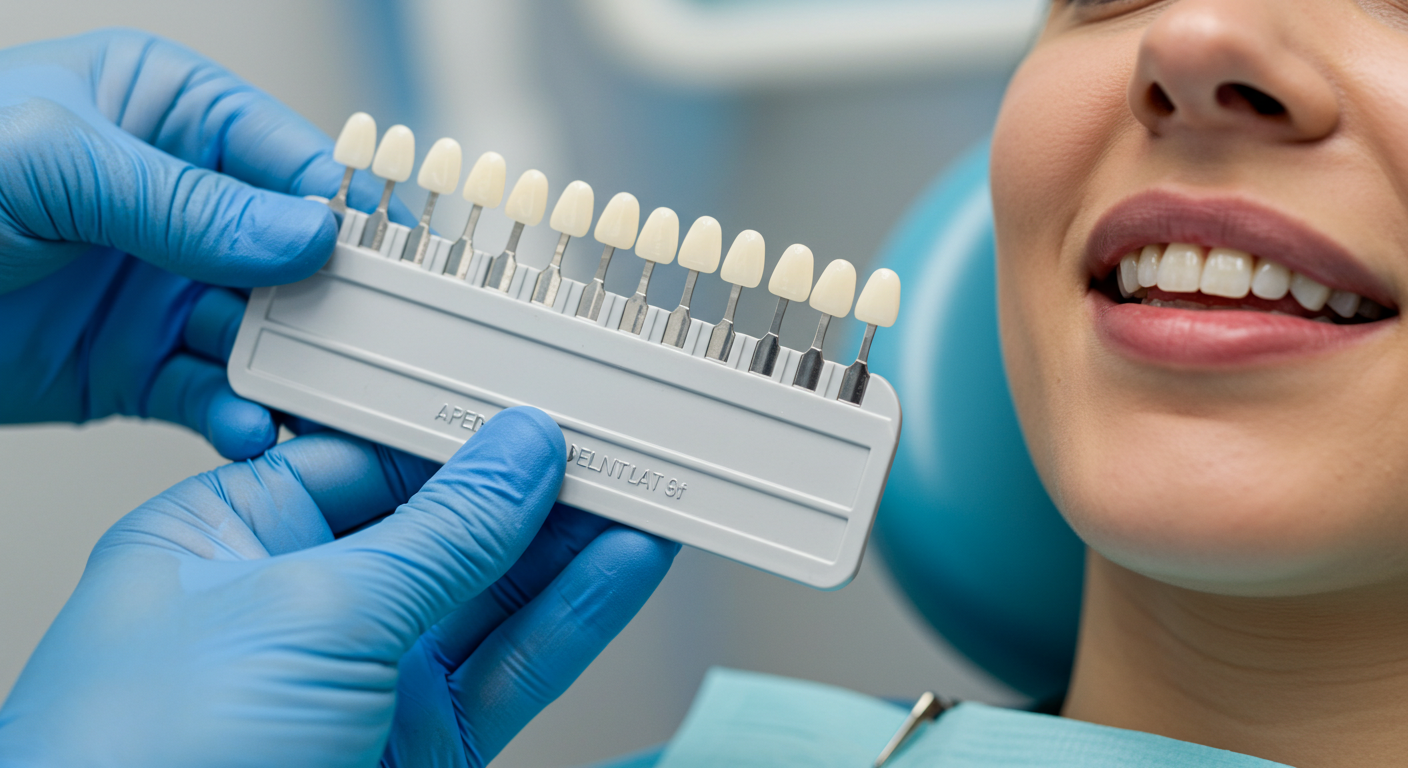Contents

Dental Bonding: Definition, Procedure, Advantages, and Cost
Dental bonding is a cosmetic dentistry technique that has helped many people achieve a more harmonious smile and gain confidence. But what exactly does this treatment involve?
This article explores the definition of composite dental bonding, its indications, the procedure, and the necessary post-treatment care. We will also discuss its advantages, disadvantages, and cost to help you determine if this solution is right for you.
Let's discover together how dental bonding can potentially transform your smile and well-being.
What is Dental Bonding?
What is dental bonding?
Dental bonding (or composite bonding) is a cosmetic procedure where a tooth-colored composite resin is applied and sculpted directly onto the tooth to improve its appearance. This resin is then hardened with a special light, chemically bonding it to the tooth.
The treatment is personalized: the dentist chooses a resin shade that perfectly matches your natural teeth for a discreet and aesthetic result.
When Is Dental Bonding Used?
Dental bonding is a versatile solution that can be considered for correcting various minor cosmetic and functional defects. Here are its most common applications:

Minor Enamel Loss
When the enamel is worn or thin, the tooth becomes more fragile and sensitive. Bonding allows a protective layer of resin to be applied to the weakened area, strengthening the tooth and reducing sensitivity.
Slight Dental Crowding
For very minor overlaps, the dentist can subtly reshape certain teeth with resin to mask the imperfection and create an illusion of alignment. Note that this does not correct the position of the teeth; orthodontic treatment is the solution for true alignment problems.
Closing Gaps (Diastema)
Composite bonding is often used to close or reduce small gaps between teeth (diastemas), especially between the front teeth. It's a quick, less invasive solution than veneers or orthodontics for this type of issue. The dentist sculpts the resin to naturally fill the space.
Slightly Crooked Teeth
Similar to crowding, for a very slightly misplaced or rotated tooth, bonding can "cheat" its shape to improve the overall harmony of the smile. Again, an orthodontic consultation is necessary to determine if this is a viable solution or if alignment treatment is preferable.
Repairing a Chipped or Broken Tooth
This is one of the most frequent indications. The composite allows for the aesthetic and functional reconstruction of a small broken corner or chip, restoring the tooth's original shape.
An examination is essential before bonding a broken tooth to ensure there is no deeper damage (nerve involvement, significant crack).
Gum Recession
When the gum recedes, it exposes the tooth root, which is often more sensitive and less aesthetic. In some minor cases, bonding can be used to cover the exposed part of the root, protecting it and improving the appearance. However, the cause of the recession must be addressed first.
Minor Discolorations or Stains
Bonding can mask certain intrinsic stains or minor discolorations that do not respond to whitening. However, for significant or widespread discolorations, other solutions like veneers or crowns are often more appropriate.

What Is the Dental Bonding Procedure Like?
Composite dental bonding is usually completed in a single dental visit and follows these steps:
- Consultation and Shade Selection: The dentist assesses your needs, confirms that bonding is appropriate, and selects a composite resin shade that closely matches your natural teeth.
- Tooth Preparation: The tooth surface is lightly roughened using a mild etching gel. This creates a microporous surface for a stronger bond. A bonding agent is then applied. This step is painless and preserves enamel.
- Resin Application and Sculpting: The dentist applies the composite resin, which has a putty-like consistency, to the tooth. They meticulously sculpt and shape it to achieve the desired form and appearance.
- Curing (Hardening): A special light (often blue) is used to rapidly harden the composite resin. Each layer of resin is cured for a few seconds.
- Polishing and Finishing: Once the resin is hardened, the dentist refines the shape, adjusts the bite, and polishes the surface to give it a smooth, glossy finish that mimics natural enamel.
Advantages and Disadvantages of Dental Bonding
Like any procedure, dental bonding has pros and cons to consider:
The Advantages
- Minimally Invasive: Unlike veneers or crowns, it requires little to no removal of healthy enamel.
- Fast: The procedure is often completed in a single visit, providing immediate results.
- Economical: It is one of the most affordable cosmetic dentistry options.
- Versatile: Can correct various minor aesthetic flaws.
- Repairable: If the composite chips or breaks, it can often be easily repaired.
- Reversible (in theory): Since little enamel is removed, the composite can technically be removed.
The Disadvantages
- Prone to Staining: Composite resin can stain over time, especially with regular consumption of coffee, tea, red wine, or tobacco.
- Limited Durability: The composite is not as strong as natural enamel or porcelain. It can chip, crack, or wear down more quickly.
- Lifespan: Bonding typically lasts 5 to 10 years, depending on the patient's habits and care.
- Limited Indications: Not suitable for major defects (large gaps, significant fractures, severe misalignments).
Care and Maintenance After Dental Bonding
To maximize the lifespan and aesthetics of your dental bonding, good care is essential:
- Maintain excellent oral hygiene.
- Regular dental visits for check-ups and professional cleanings.
- Limit staining foods/beverages.
- Avoid biting hard objects.
- Be cautious with very hard or sticky foods.
- Wear a night guard for bruxism or a mouthguard for contact sports.

Dental Bonding vs. Veneers: Which to Choose?
The choice between bonding and veneers depends on several factors. Here is a quick comparison:
Objective
- Bonding: Minor corrections (small chips, gaps, light stains).
- Veneers (Porcelain): More significant corrections (larger gaps, heavily worn teeth, deep discoloration).
Materials
- Bonding: Composite resin.
- Veneers: Primarily porcelain (highly aesthetic, stain-resistant, durable).
Procedure
- Bonding: Usually 1 appointment, little to no enamel removal.
- Porcelain Veneers: 2+ appointments (preparation/impression then bonding), requires removal of a thin layer of enamel.
Lifespan
- Bonding: 5-10 years on average.
- Porcelain Veneers: 10-15 years or more.
Cost
- Bonding: Most affordable, around $300 - $600 per tooth.
- Porcelain Veneers: Significantly more expensive, often $925 - $2,500 per tooth.
The final decision should be made after a discussion with your dentist.
Cost of Dental Bonding in the US
As mentioned, the average cost of composite dental bonding in the United States typically ranges from $300 to $600 per tooth. This price can vary depending on the complexity of the case, the location of the practice, the practitioner's reputation, and the extent of the surface to be covered.
It's important to note that dental bonding is considered a cosmetic procedure and is not typically covered by dental insurance. Some plans may offer limited coverage if the bonding is for a structural reason (like a chip), but it's rare for purely cosmetic applications.
Frequently Asked Questions About Dental Bonding
How long does composite bonding last?
On average, 5 to 10 years, but this depends heavily on your hygiene, dietary habits, and the absence of parafunctional habits (like bruxism).
Does dental bonding hurt?
No, the procedure is generally painless as it works on the tooth's surface. No anesthesia is usually necessary unless the bonding is very close to the nerve or a cavity needs to be treated simultaneously.
Can you whiten dental bonding?
No, composite resin does not respond to whitening products. If you're considering whitening, you should do it before the bonding. The dentist will then choose a composite shade that matches your whitened teeth.
Is dental bonding compatible with teeth grinding (bruxism)?
It's possible, but bruxism significantly increases the risk of fracture or premature wear of the composite. It is strongly recommended to treat bruxism (e.g., with a night guard) before or concurrently with bonding. For severe grinders, more resistant solutions like porcelain veneers or crowns may be preferable.
Can dental bonding be removed?
Yes, a dentist can remove the composite. However, even if the initial preparation was minimal, the removal process might slightly alter the underlying enamel surface. This is a decision to be discussed with your practitioner.
Can bonding be done if I have gum disease?
No, it is imperative to treat and stabilize any gum disease (gingivitis, periodontitis) before performing dental bonding. Placing composite on unhealthy gums could worsen the problem.
